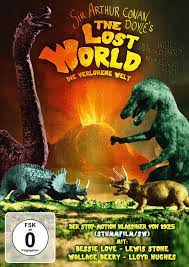
Returning from a lost expedition at the junction of Peru, Brazil, and Colombia, Paula White (Bessie Love) brings home to London the journal of her missing father Maple White and delivers it to the eccentric Professor Challenger (Wallace Beery). The sketches of dinosaurs therein prompt Challenger to declare that dinosaurs still live. Of course, he is ridiculed by the stuffy academics at the Zoological Hall.
Though he hates journalists, he accepts the challenge (and the funds) of a newspaper to lead a rescue mission to bring back Maple White. Joining him are Paula White herself, hunter Sir John Roxton (Lewis Stone), a reporter named Edward Malone (Lloyd Hughes), the sceptical rival scientist Professor Summerlee (Arthur Hoyt), an Indian servant named Zambo (Jules Cowles), and Challenger’s butler Austin (Francis Finch-Smiles). Malone is coming along because his betrothed thinks he should be more adventurous and manly. Both he and Roxton develop feelings for Paula.
After a long journey, they arrive at the base of the plateau described and set up camp. A large rock thrown by a caveman (Bull Montana) from the top of the plateau nearly kills them. Looking up, they see a Pterodactyl (actually, a Pteranodon) busily eating a pig alive. Leaving Zambo and Austin at camp, they cross a chasm onto the plateau, using a tree they have cut down, but it is knocked down by a Brontosaurus (later called an Apatosaurus and now a Brontosaurus again), and they are trapped.
They see an Allosaurus attacking a Trachodon, then driven off by a Triceratops, but it then attacks the camp and is held off by Malone with a flaming torch. He climbs a tree to look out but is attacked by the Apeman. The Allosaurus attacks an Agathaumas and is gored to death, but a Tyrannosaurus kills the Agathaumas and a nearby Pteranodon. The frightened explorers set up to live on the plateau indefinitely. Challenger builds a catapult. Roxton finds the remains of Maple White. Ed Malone professes his love for Paula, and Summerlee, who used to be a minister, marries them.
As they observe the Brontosaurus, it is attacked by an Allosaurus and falls off the plateau into the muddy bank of a river below. A volcano erupts, causing a stampede of giant creatures, but the crew is saved by Paula’s pet monkey Jocko (himself), who climbs up the cliff with a rope. They haul up a rope-ladder and climb down. The Apeman attacks them on the way down and Roxton kills him. They find the Brontosaurus trapped alive in the mud and Challenger brings it back to London to prove his story.
However, as it is being unloaded from the ship, it panics and escapes into the London streets. Its weight causes the Tower Bridge to collapse and it swims down the river Thames. Challenger is disappointed. Ed Malone discovers that the girl he left behind gave up on him and got married, so he gets to marry Paula. Roxton hides his disappointment behind his stiff upper lip as they leave together.
This silent film was directed by Harry O. Hoyt and produced by Earl Hudson, based on Sir Arthur Conan Doyle’s 1912 novel. The script was by Marion Fairfax. There was a short introduction to the film, missing from some prints, featuring Conan Doyle himself. Doyle always said his favorite character was Professor Challenger, not Sherlock Holmes. The film was not only the first feature-film ever made with the stop-motion animation of Willis O’Brien, with the dinosaurs based on the artwork of Charles K. Knight, it was also the first film ever shown on a plane, on a London-Paris flight in 1925. The Handley-Page plane was made of wood and fabric and the film was on highly flammable nitrate stock, so this was actually quite dangerous. There is a restored, one hour and 44-minute, HD version of the film with Conan Doyle’s intro on Wikipedia, and there are several good prints on video.
The dinosaur miniatures were donated to the Museum of Arts and Sciences in Los Angeles. Beginning to rot in time, they were stored away and inadvertently sealed between the walls during the construction of a new wing. At the time, the theory was that evolution was a long climb to the perfection of the human race, and the dinosaurs were sluggish swamp creatures and dumb evolutionary failures, but the film portrayed them as active and land-dwelling. Too bad later films did not try to build on Willis O’Brien’s work. It took three men to operate the Bronto’s head, and a football bladder was used to make it seem to breathe. In the novel, it is a Pterodactyl which is brought back and released in London, and there are no women in the expedition. The way the Brontosaurus crashed through the Tower Bridge was used later in The Giant Behemoth (1959). This film is one of the very few to have a 100% rating on Rotten Tomatoes.
